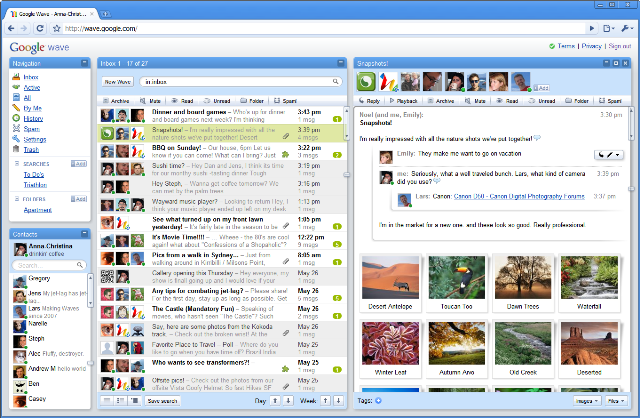Riding the Google Wave
Lars Rasmussen, a software engineering manager at Google, first connected with the company when, in 2004, Google took an interest in a mapping startup called Where 2 Tech that he founded with his brother Jens. They joined Google and helped to create what would become Google Maps.
What next? They realized 2 big killer apps - email and instant messaging - basically imitate analog formats. Email is based on "snail mail" and IM follows the model of phone calls. Taking into account what has come since - blogs, wikis, collaborative documents and much improved computers and networks - got them thinking about their next project.
They codenamed it "Walkabout" and we now know it as Google Wave.
We have seen a demo of what it is intended to be. It attempts to erase the lines between email and chat and conversation versus documents to a single web continuum. It doesn't start by imitating non-electronic forms, but by thinking through the digital potentials.
A "wave" itself is a combination conversation and document. I suppose it rolls on like a watery wave but of flowing photos, videos, maps, and more. You catch a wave, then you add people to it. That's not something ocean surfers enjoy, but its a collaboration that digital surfers would enjoy. Everyone riding your wave can use richly formatted text, photos, gadgets, feeds from other web sources, insert a reply or edit the wave directly. Because it is synchronous rich-text editing, you will see the results on your screen nearly instantly when your fellow waveriders are collaborating. Now, this is cool. You can also use "playback" to rewind the wave and see how it evolved.
The code for Wave will be open source to encourage the developer community to get involved.
There are 3 layers to Google Wave: product, platform, and the protocol. The product is the web application people will use to access and edit waves.
You can also think of Wave as a platform with open APIs that allows developers to embed waves in other web services, and to build new extensions that work inside waves.
The protocol is more geeky. Lars Rasmussen describes it this way:
What else do you think we can or should do with the Wave in educational settings?
What next? They realized 2 big killer apps - email and instant messaging - basically imitate analog formats. Email is based on "snail mail" and IM follows the model of phone calls. Taking into account what has come since - blogs, wikis, collaborative documents and much improved computers and networks - got them thinking about their next project.
They codenamed it "Walkabout" and we now know it as Google Wave.
We have seen a demo of what it is intended to be. It attempts to erase the lines between email and chat and conversation versus documents to a single web continuum. It doesn't start by imitating non-electronic forms, but by thinking through the digital potentials.
A "wave" itself is a combination conversation and document. I suppose it rolls on like a watery wave but of flowing photos, videos, maps, and more. You catch a wave, then you add people to it. That's not something ocean surfers enjoy, but its a collaboration that digital surfers would enjoy. Everyone riding your wave can use richly formatted text, photos, gadgets, feeds from other web sources, insert a reply or edit the wave directly. Because it is synchronous rich-text editing, you will see the results on your screen nearly instantly when your fellow waveriders are collaborating. Now, this is cool. You can also use "playback" to rewind the wave and see how it evolved.
The code for Wave will be open source to encourage the developer community to get involved.
There are 3 layers to Google Wave: product, platform, and the protocol. The product is the web application people will use to access and edit waves.
You can also think of Wave as a platform with open APIs that allows developers to embed waves in other web services, and to build new extensions that work inside waves.
The protocol is more geeky. Lars Rasmussen describes it this way:
"The Google Wave is the underlying format for storing and the means of sharing waves, and includes the "live" concurrency control, which allows edits to be reflected instantly across users and services. The protocol is designed for open federation, such that anyone's Wave services can interoperate with each other and with the Google Wave service. To encourage adoption of the protocol, we intend to open source the code behind Google Wave. So, this leaves one big question we need your help answering: What else can we do with this?"
What else do you think we can or should do with the Wave in educational settings?

Comments
No comments